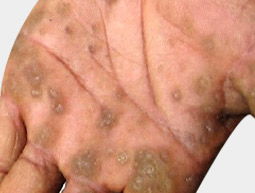
Genetic factors that raise the risk for skin lesions in people repeatedly exposed to arsenic have been identified in one of the first large-scale genomic studies done in Bangladesh.
Genetic changes that take place around the enzyme for metabolizing the chemical into a less toxic form can considerably add to an individual's risk for developing arsenic-related disease.
Researchers at the University of Chicago Medicine, Columbia University's Mailman School of Public Health, and in Bangladesh said that the discovery could point the measures to new screening and intervention options for people who are exposed to groundwater with high concentration of arsenic.
The group's genome-wide association study, or GWAS, was conducted on around 3,000 individuals exposed to arsenic for decades in Bangladesh.
Since the extensive installation of hand-pumped wells to tap groundwater sources in the 1970s, as many as 77 million people - that is nearly half the population of Bangladesh - have been accidentally came in contact with dangerous levels of arsenic. The World Health Organization terms this exposure 'the largest mass poisoning of a population in history.'
For over a decade, the team of researcher has studied the epidemiology of arsenic-related ailments, such as skin lesions, diabetes, and respiratory diseases, in this population, as well as the efficiency of interventions to check toxicity. In this recent study, the researchers tried to get genetic answers for why some individuals seems to be at higher risk for developing the disease after getting exposed to arsenic.
"These results add clarity to the genetic architecture that is playing a role in arsenic toxicity and its underlying biology," senior author Habibul Ahsan, MD, MMedSc, Louis Block Professor of health
"It's a rare type of study for a major problem affecting millions of people around the world, and it opens up opportunities for genetic studies of other major public health problems in developing countries," he added.
The scientists genotyped thousands of arsenic-exposed people from the group's main studies for single nucleotide polymorphisms (SNPs) throughout the genome, and examined its associations with arsenic metabolite levels and risk of skin lesions.
The genetic findings strongly proved that efficient metabolism of arsenic through methylation protects from the toxin. Compounds that boost methylation like folic acid could decrease arsenic toxicity - a strategy currently being tested by co-author Mary Gamble, PhD, associate professor of Environmental Health Sciences at Columbia University's Mailman School of Public Health.
"If we could somehow find a way to do that in Bangladesh, it would make individuals much better methylators of arsenic, and as this current study shows if you're a better methylator you're at a lower risk for disease,” co-author Joseph Graziano, PhD, professor of Environmental Health Sciences and Director of Superfund Research Program at the Mailman School of Public Health of Columbia University has been quoted as saying.
More than the clinical applications, the current research shows that large-scale genomic studies are possible in a largely rural population of a developing country.
PLoS Genetics has published these research findings.
--with inputs from ANI
|
|
Read More: Bangladesh | Health | Union Public Service Commissio | C.s.k.m. School | S P School Edso | D.a.v.hr/sec School | Sainik School Kapurthala Ndtso | Public Service Commission | Public Office | Hyderabad Public School | Gadag Health Camp | Karnata Health Institute | Ponneri Public Office | Chengalpattu Public Offices | Cuddalore Public Offices | Papanasam Public Office | Ramnanathapuram Public Offices | Periyakulam Public Office | Health Institute Po | Orga | K.r.high School


Comments: